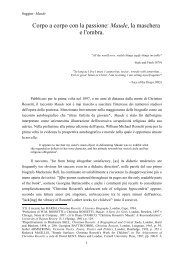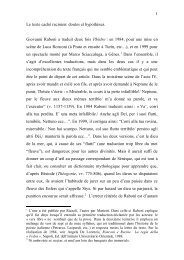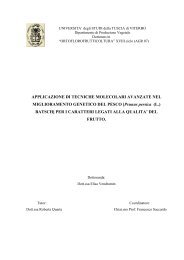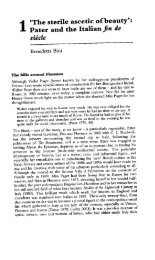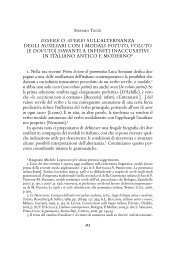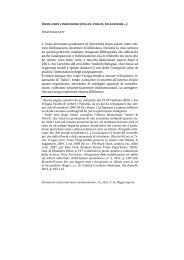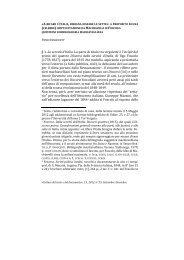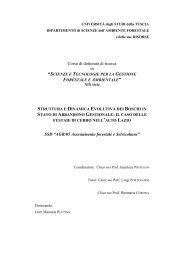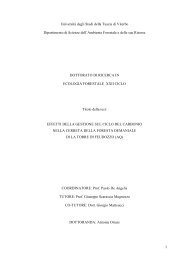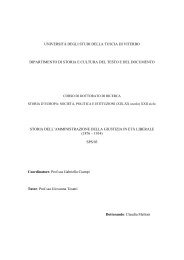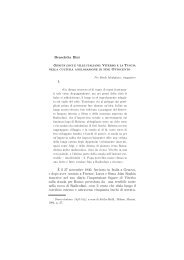drivers of soil respiration of root and microbial ... - Unitus DSpace
drivers of soil respiration of root and microbial ... - Unitus DSpace
drivers of soil respiration of root and microbial ... - Unitus DSpace
Create successful ePaper yourself
Turn your PDF publications into a flip-book with our unique Google optimized e-Paper software.
2.4. Discussion<br />
2.4.1. Partitioning <strong>of</strong> <strong>soil</strong> <strong>respiration</strong><br />
56<br />
In our study the relative contribution <strong>of</strong> Ra to total CO2 efflux over the 3 years amounted to<br />
29%. During the growing seasons the relative contribution <strong>of</strong> Ra varied from 2 to 70%, however an<br />
increase in the relative input <strong>of</strong> <strong>root</strong> <strong>respiration</strong> to the total one was associated mainly with a<br />
considerable decrease in <strong>microbial</strong> <strong>respiration</strong> under the water stress conditions (Fig. 3). The<br />
observed average value <strong>of</strong> <strong>root</strong> contribution to <strong>soil</strong> <strong>respiration</strong> is less than 38-40% <strong>and</strong> 43-56%<br />
reported respectively by Craine et al. (1999) <strong>and</strong> Wang et al. (2007) for temperate grassl<strong>and</strong>s, <strong>and</strong><br />
39-41% reported by Tang et al. (2005) for oak-savannah. The lower value could be attributed to the<br />
fact that Amplero is subjected to the annual mowing <strong>and</strong> grazing, which influence the<br />
photosynthetic C supply to <strong>root</strong>s <strong>and</strong> thus <strong>root</strong> <strong>respiration</strong> itself (see below). In fact, our estimate is<br />
consistent with the results obtained in semi-arid grazed grassl<strong>and</strong> <strong>of</strong> China (15%-37% by Li et al.,<br />
2002). The methods used for partitioning also vary between various studies, each with its own<br />
shortcomings <strong>and</strong> limitations, which could also influence the final result, making the comparison<br />
between studies especially difficult.<br />
As all <strong>soil</strong> <strong>respiration</strong> partitioning methods, the calculated here fluxes are an approximation<br />
<strong>of</strong> real field fluxes. The mesh-exclusion technique we used to partition <strong>soil</strong> <strong>respiration</strong> is associated<br />
with various limitations <strong>and</strong> assumptions, which result in a possible overestimation <strong>of</strong> <strong>microbial</strong>-<br />
derived <strong>respiration</strong> <strong>and</strong> underestimation <strong>of</strong> <strong>root</strong>-derived one. Namely, the shortcomings <strong>of</strong> the<br />
method are: disturbance <strong>of</strong> the <strong>soil</strong> structure by sieving, lateral diffusion <strong>of</strong> CO2 (Jassal <strong>and</strong> Black,<br />
2006) to the mesh bags from the surrounding <strong>soil</strong> <strong>and</strong> inability to separate <strong>root</strong> <strong>respiration</strong> from<br />
rhizo<strong>microbial</strong> one. The advantage <strong>of</strong> the nylon mesh bag technique over other trenching <strong>and</strong> <strong>root</strong>-<br />
exclusion methods is that it permits to exclude <strong>and</strong> control the <strong>root</strong>s in-growth inside the plot <strong>and</strong> in<br />
the same time allows the exchange <strong>of</strong> water <strong>and</strong> other substances with an exterior <strong>soil</strong>.<br />
We tried to minimise the effect <strong>of</strong> the <strong>soil</strong> disturbance on <strong>microbial</strong> activity <strong>and</strong> <strong>respiration</strong><br />
fluxes by installing an additional mesh <strong>of</strong> 1cm, <strong>and</strong> obtaining the value <strong>of</strong> <strong>root</strong>-derived <strong>respiration</strong><br />
as a difference between two meshes with the equally disturbed <strong>soil</strong>. However, here we make an<br />
assumption that there is no difference in the in-growth patterns <strong>of</strong> <strong>root</strong>s between non disturbed <strong>soil</strong><br />
<strong>and</strong> <strong>soil</strong> which was previously sieved. Microbial-derived <strong>respiration</strong> was calculated further from the<br />
difference between control (non disturbed <strong>soil</strong>) plots <strong>and</strong> <strong>root</strong> <strong>respiration</strong>. The rate <strong>of</strong> the influence<br />
<strong>of</strong> the lateral diffusion <strong>of</strong> CO2 from the surrounding <strong>soil</strong> is difficult to estimate. Moyano et al.<br />
(2008) reported a value <strong>of</strong> ca. 10%. It results in a systematic overestimation <strong>of</strong> the <strong>microbial</strong>-<br />
derived <strong>respiration</strong>. Here we make a second assumption: the influence <strong>of</strong> the lateral flow <strong>of</strong> CO2 is<br />
constant during the growing season, <strong>and</strong> doesn’ t modify the seasonal trend in contribution <strong>of</strong> <strong>soil</strong><br />
<strong>respiration</strong> components to the total one.




